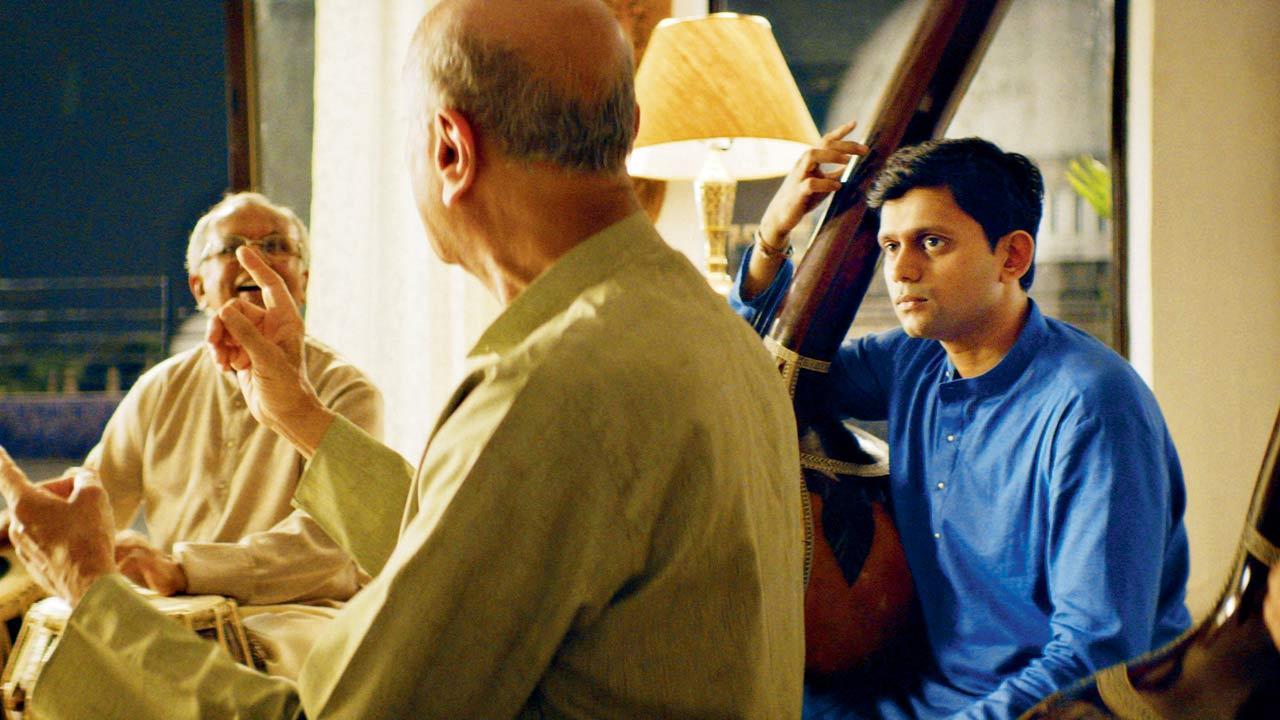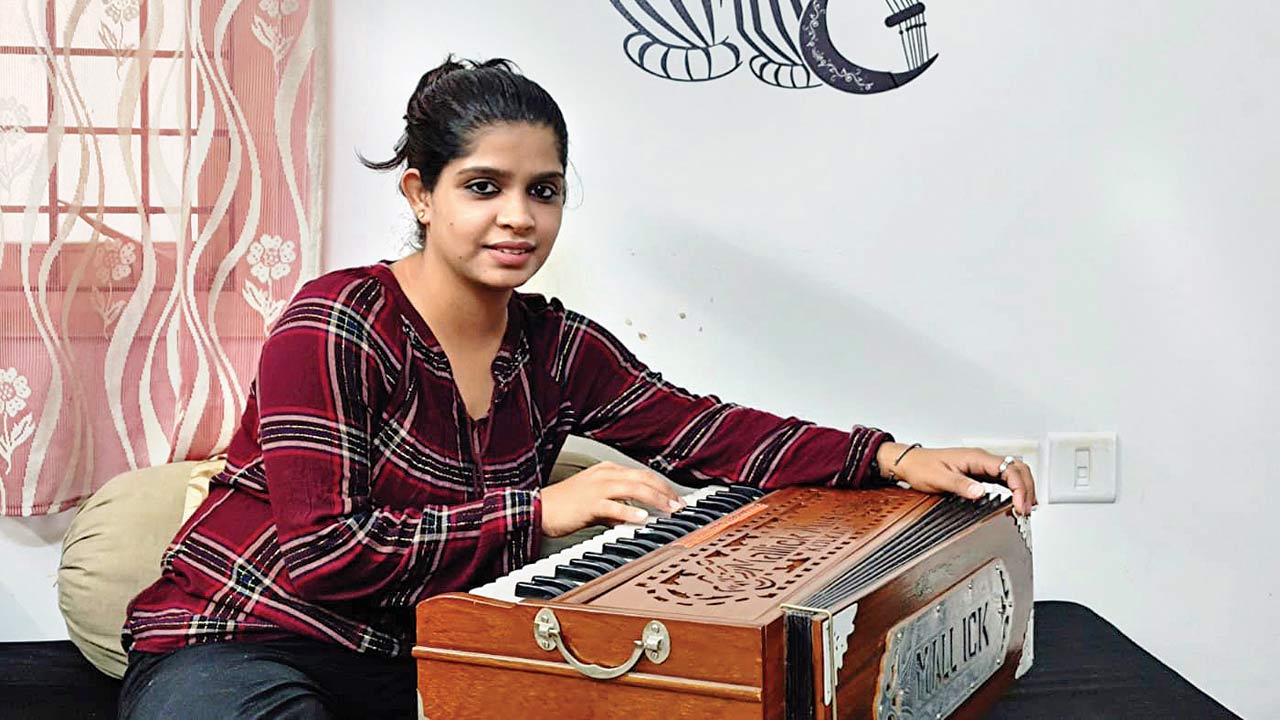As a music festival in the city celebrates guru-shishya parampara, we ask if students today can be bound by ties of obedience, devotion and spirituality, adapted to the age of online classes and electronic tanpuras?

Chaitanya Tamhane’s film The Disciple probed themes of devotion, spirituality, learning and performance through the character of a classical singer, presenting his relationship with his guru and later his pupils
This weekend saw the start of the 11th edition of the National Centre for the Performing Arts’ (NCPA) and Citi India’s Aadi Anant: From Here to Eternity festival in Mumbai. The celebration, opened by renowned sitar player and Grammy-nominated artiste Shujaat Khan, who designs his performances around a rendition of the classical art form that he has grown up within, with Sufi and folk elements, will also host performances by Carnatic vocalist TM Krishna and his troupe, and Shantanu Moitra, Ani Choying, Kaushiki Chakrabarty and others in January. The festival, originally a travelling event, is limited only to Mumbai this year given pandemic restrictions, and is part of a larger programme run by Citi and the NCPA to celebrate the guru-shishya tradition, focused on a relationship of devotion, obedience and spirituality in the passing on of knowledge from the guru to the disciple.
Dr Suvarnalata Rao, musicologist, trained sitar player and head of Indian music programming at the NCPA, speaks of a predominantly oral and aural tradition in Indian music that has come to us through the guru-shishya tradition, the emphasis being on performing and listening rather than writing down, thereby making this kind of mentorship vital and allowing for an unbroken transference of knowledge through centuries. Even within the Indian musical tradition’s stringent grammar, it has left the space open for interpretation, she says.
ADVERTISEMENT
Eminent Carnatic singer Aruna Sairam, who recently joined Mumbai-based online music education platform Artium Academy as faculty head, says that at the time when she was under training, it was not just music that one learnt from one’s guru, but also how to mould one’s character. “There were no technological aids. Tape-recorders were around in those days but they were those big spools and it wasn’t possible to record lessons on the spool recorder. We did not have cassettes […] So, whatever you learnt and remembered from your interaction with the teacher is what you took home with you. When I say took home, [I mean] you took in with you, into your conscious and subconscious mind and then you presented it before the guru. So it was a completely different way of learning. Today, fortunately, we have a lot of aids where you can play and replay the files and go over each micro-moment of the lesson and make your own learning a lot more perfect and efficient,” she says.
Shivani Mirajkar, shishya of Shri Ulhas Kashalkar, and one of the beneficiaries of Citi and NCPA’s guru-shishya focused initiatives, feels that within the guru shishya tradition, “disciples not only learn music, but ways of thinking, techniques, rules and discipline”. Her training, she says, has taught her to be unique and to never mimic anyone, even her own guru.
“When you are introduced to a musician, the first question you are asked is who you learnt from,” says Shujaat Khan, explaining how the practice underlines the prominence of the teacher and how the shastras lay out that between a guru and god, one must choose the former as he will teach you how to get to god. “It is nice that such projects and events highlight the importance of this relationship.”
Among the Citi-NCPA initiatives celebrating this bond are one in which eight gurus receive financial support to train three promising disciples each, and a second where nine scholarships are awarded annually to talented amateurs in the field of Hindustani music based on auditions. “We are trying to create the next generation of artistes,” says Dr Rao pointing out how the beneficiaries are young people, who are being given the opportunity to showcase their talent at the NCPA. The financial support advanced through such coveted scholarships will enable them to continue their musical practice. At the same time, the initiatives also are driven towards nurturing tomorrow’s listeners, while using music as a way to spur mental growth through a programme that trains school children in Indian music, most of them from underprivileged backgrounds, covering approximately 350 students from 12 schools.
The guru-shishya tradition, however, has evolved with the times especially with online learning during the pandemic. Ankita Tiwari, Sangeet Visharad, and teacher at the Sangeet Music Academy, Hyderabad, has participated in online classes for the past two years and is only starting to meet her students in person.
 Ankita Tiwari
Ankita Tiwari
Teaching methods have changed too, she says, along with teachers who given the changing times, are not permitted to be as strict as they used to be. “When I was learning, we used to take six-seven months to learn a single raga. These days, people want to learn quickly through YouTube,” says Tiwari, while admitting that accessories like electronic tanpuras and one-on-one sessions that the online mode has enabled has brought ease to practice sessions, while allowing students more access to teachers. “When I was learning, there were 20 students in the class and getting five minutes of the guru’s time meant a lot.” But for Yashwe Taparia, Tiwari’s student and a member of the Academy, online classes proved altogether too difficult, without a tabla accompaniment to help with rhythm, for instance. For the eight-year-old, the restarting of in-person classes from this week means not only taking up her singing lessons again, but also getting to learn from Tiwari in person.
 YasHwe Taparia
YasHwe Taparia
“I am absolutely against this online culture,” Khan tells us. “Our music is all to do with touch, feel and spirituality. It is not something that can be expressed, heard, presented and performed on a screen to another person who is watching. The whole system of Skype lessons makes a fool of the student.”
 Zakir Hussain performing at the eighth edition of Citi NCPA Aadi Anant Festival in 2018. Pic/CITI-NCPA AADI ANANT (2018)
Zakir Hussain performing at the eighth edition of Citi NCPA Aadi Anant Festival in 2018. Pic/CITI-NCPA AADI ANANT (2018)
But the tradition, originally involving the disciple’s stay at the guru’s home for a span of 20-30 years, and involving seva and dedication in return for knowledge, has undergone updation in other ways. “The relationship between a teacher and a student in a tradition like ours has to adapt to change, but the importance of that relationship has not diminished at all,” says Khan. “We have to understand that the student can’t just leave his house and live with the guru for years, and the student has to understand that the teacher can’t be available 24 hours a day, explaining how the ancient practice endures, but is focused in shorter periods of time. “My students travel from different parts of the world, come to my city, find a place close to my house and live there for the time that is available to them,” says Khan, explaining that such continuous learning and involvement, even when restricted to short periods, has benefits. “Some artistes emote best late at night, some early in the morning. If the student is always around you, they will get the best from you at the best time.”
 Dr Suvarnalata Rao, Shujaat Khan and Aruna Sairam
Dr Suvarnalata Rao, Shujaat Khan and Aruna Sairam
 Subscribe today by clicking the link and stay updated with the latest news!" Click here!
Subscribe today by clicking the link and stay updated with the latest news!" Click here!








